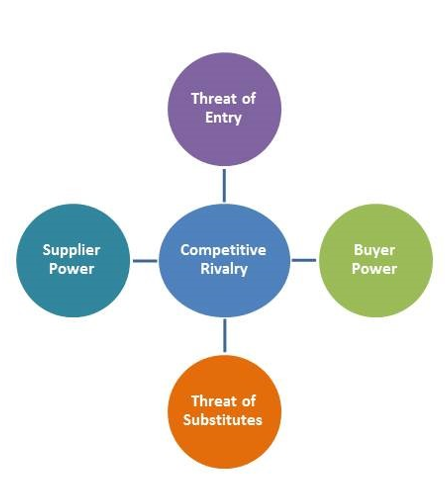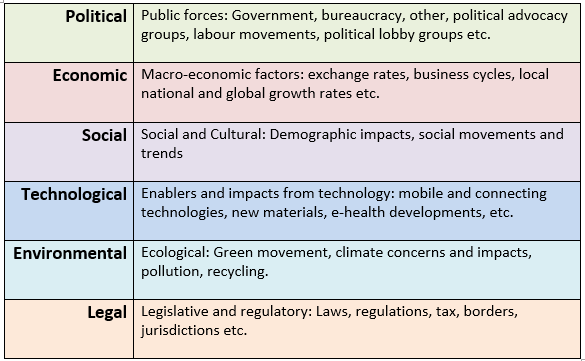Module 2: Diagnosis, Identifying capabilities, resources and processes
Topic 2.2: Exploring the Organisation’s Operating Environment
What is an organisation’s operating environment? It has two parts. It is all things external to your organisation and it can be fluid, relatively fixed or chaotic. It includes clients, the public, suppliers, other organisations and is subject to political, economic and social forces. An intimate knowledge of the environment is needed to continually reassess whether products, policy or services are continuing to create value. A different mindset for coping with change is needed.
(Van der Heijden et al. 2002:13)[1].
It is also all things internal to your organisation. These are significantly impacted by, and interact with, the external environment. Some strategists and strategy thinkers see a distinct separation between external and internal. Our suggestion is to think of a system of integrating ‘parts’. If we employ complexity theory concepts, we would believe that organisations are systems that act ‘in an intimate relationship and as constantly conducting exchanges with their environment’ (Jackson, 2003:116)[2].
Let’s begin:
Exploring the organisation’s external environment
One of the fundamental and ‘first step’ pieces of analysis that is used to examine the macro-environment is the Porter’s Five Forces Framework (Johnson et al. 2014)[3].
While this was developed originally to explore the dynamics of industries, it can be adapted to many scenarios and contexts. We suggest that in this era of public value, characterised by factors such as outsourcing, contestability, ‘agency as overseer, not doer’, a good understanding of the environmental ‘dynamics’ is crucial.
Porter’s Five Forces Framework
In the corporate for profit world, the Five Forces tool is a standard well-used external analysis tool that is applied to address the questions of:
- What is the overall set of dynamics of the business environment?
- How is the business’s operating environment likely to change over time?
- Should we be in this business?
As you can see, these questions can likely be adapted to your context. The questions are then answered by calculating the ‘attractiveness rating’ of five competitive forces. The five forces are:
| Potential Entrants | What is the threat of entry by new entities that might offer similar products or services with the industry?
(Hint: could for example an NGO or non-profit begin to deliver a competing offering to your agency) |
| Substitutes | What is the threat of substitutes to the existing industry or service context that might replace the current business model or offering with a similar benefit?
(Hint: e-document services replacing the service division of an agency, rendering that division irrelevant) |
| Buyer Bargaining Power | What is the threat of buyers? (users, clients) demanding greater value in various forms (immediate customers?) |
| Supplier Bargaining Power | What is the power of crucial suppliers to create a threat or disruption through control over inputs?
(Hint: labour being scare, services provided by suppliers such as technology firms) |
| Competitive Rivalry | What is the threat of competitive rivalry between existing providers (incumbents) in the industry or system to disrupt your agency’s long-term success? |
Consider whether this framework is relevant to your organisation, regardless of whether you are in the public sector, NGO or non-profit domains. Is it useful to your agency, department or project, to apply, and what might it tell you?
Follow this sequence and ask these questions.
| Supplier power | Do current or future suppliers have significant power, or perceived power, over your organisation or division?
Labour and expertise can be powerful forces that can impact the agency’s business. |
| Buyer power | Do your clients, target service recipients, or your end users, have or in the future may have, considerable power or influence over your operations, or even your existence?
Government agencies may have a small group of powerful clients. |
| Threat of entry | Are there other agencies or service providers that may decide that in an open environment, that they will offer similar services to your clients? |
| Threat of substitutes | Is there potentially a completely new service delivery model that may render some your services or even your existence, irrelevant?
Automated self-services are rapidly making many traditional services redundant. |
| Competitive Rivalry | Overall is this a ‘crowded space’ that perhaps the prevailing administration will decide the service, department or agency is in danger of being eliminated, downsized, dramatically altered, or the service moved to another delivery model? |
Figure 2.1 Porter’s 5 Forces Framework
Required
30 mins
Watch the video below and attempt to apply the model to your context. To assist you, apply a scoring mechanism; a typical might be ‘L – Low Threat’; ‘M – Medium Threat’; ‘H – High Threat’.
Fill in each of the four forces – Supplier, Entry, Buyer and Substitutes. Then consider the outcomes of each of those analyses.
- How do they inform your decision about Competitive Rivalry, and thus Attractiveness of the product or service space in which you operate?
- Does this analysis type fit your context?
- If so, what does it tell you?
- How could you adapt the model to fit, or better fit, your context?
The PESTEL Framework
The overarching purpose of a PESTEL analysis is to identity key drivers of change. We do this by exploring the trends, factors and external dynamics and ordering them into six ‘themes’:
- Political
- Economic
- Social
- Technological
- Environmental
- Legal
These themes we consider to be macro-environment forces. For a brief description of each of these themes, see the notes in Table 2.1.
Table 2.1 PESTEL Analysis Guide
(Adapted from Johnson, Whittington, Scholes, Angwin and Regner, 2014.)You will find a PESTEL template on your unit site.
It is clear that all of these six factors are eminently relevant to public sector organisations, and are often interrelated. Social factors (such as community demands for involvement and changes in wealth, education and so on) and economic and environmental changes (such as drought and climate change) are influencing the community and stakeholder expectations of outcomes and are forcing a rethink of government programs in many jurisdictions.
Below in Figure 2.2 you will note a typical ‘layout’ for a PESTEL Analysis.
Figure 2.2 PESTEL Analysis Template
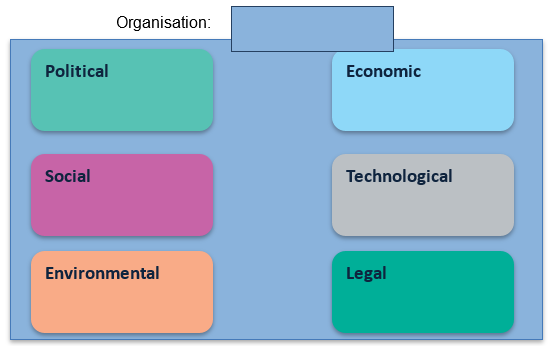
Required
30 mins
Begin to fill in the PESTEL Analysis Template in Figure 2.2 above. The Opportunities and Threats sections of your SWOT will be useful as you explore the PESTEL factors.
Take note of any of the 6 factors where there is particular emphasis. For example, in some public sectors, political and economic factors may be particularly powerful.
Bring this analysis to the Workshop.
The SWOT Analysis
The SWOT (Strengths, Weaknesses, Opportunities, Threats) Analysis tool is an integral part of strategy development, strategy assessment, and an ongoing climate check tool that is widely used in many contexts. It is highly likely that you have used, or at least experienced, this tool at many stages of your career. As well as the 4 categories, the SWOT tool has 2 internal and 2 external quadrants:
- Strengths, Weaknesses – the organisation’s internal environment
- Opportunities, Threats – the organisation’s external environment or context.
A few observations:
- A SWOT is a highly visible and useful shared process
- A SWOT should be dynamic – regular revisits are essential
- Prioritisation is important – so focus on the critical and most impactful issues, and consider these in relation to key competitors.
- Focus on those factors that are of direct relevance to the organisation of interest.
Look carefully. The PESTEL analysis is a very useful source of insights for the Opportunities, Threats section of your SWOT! The external analysis in a SWOT is likely be informed by some of all of the six PESTEL factors.
Exercises
Preparation for the Workshop
In preparation for the Workshop, watch the below video.
Begin to look around your organisation and department, and begin to populate the OT sections of a SWOT analysis of your context, to be included in your Workplace Project.
When examining the External factors in your SWOT analysis, look also for links to your Five Forces conclusions. What are the factors you sense are reinforcing each other? Can you notice a confluence here?
Look back over your Module 1 exercise where you explored the external ‘business drivers’ that impact your context. Are some of these external trends that can be considered Opportunities or Threats?
Please bring these to the Workshop.
Figure 2.3 SWOT Analysis Framework
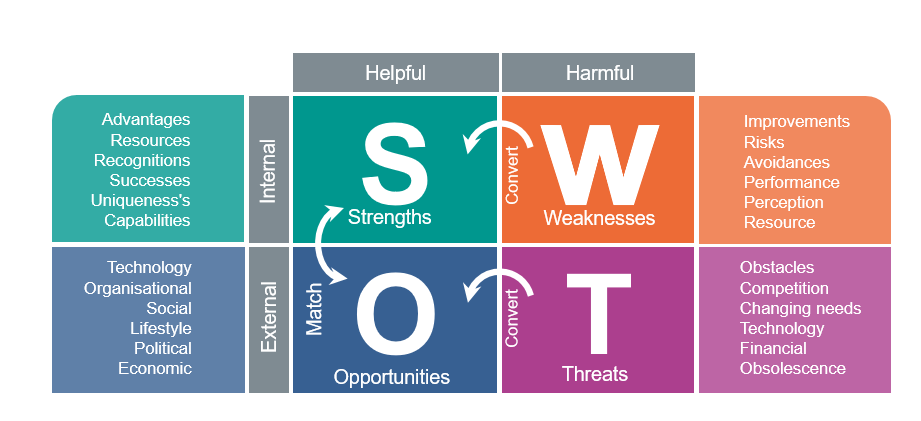
Exploring and leveraging the organisation’s internal environment
- Now let’s switch to the internal analyses. As we conduct our Internal Analyses, the primary Objectives are to:
- Identify resources and capabilities that are potential foundations for competitive advantage and/or exemplary performance
- Understand organisational strengths and weaknesses in context
- Build insights into how to leverage those resources and strengths to best advantage to deliver value using the resources most affectively.
There are two widely used and powerful tools to apply. The first is to complete the SW (Strengths; Weakness) section of the SWOT analysis. These directly deal with internal factors within an organisation.
An analysis of an organisation’s capabilities, or lack of them, informs the SW section of a SWOT. An important concept here is the resource-based view of an organisation. What resources, competencies and capabilities does the organisation have? Competitive advantage could be ‘what your agency, team, division has that enables it to be considered in preference to other alternative service/delivery providers’. How can these be leveraged to deliver value – and to achieve outcomes – in your case typically societal benefits rather than ‘superior profitability’, although you could substitute ‘more effectively and efficiently, with the highest level of public value’ or something similar, as an end variable?
Figure 2.4: The Resource Based View of the Organisation
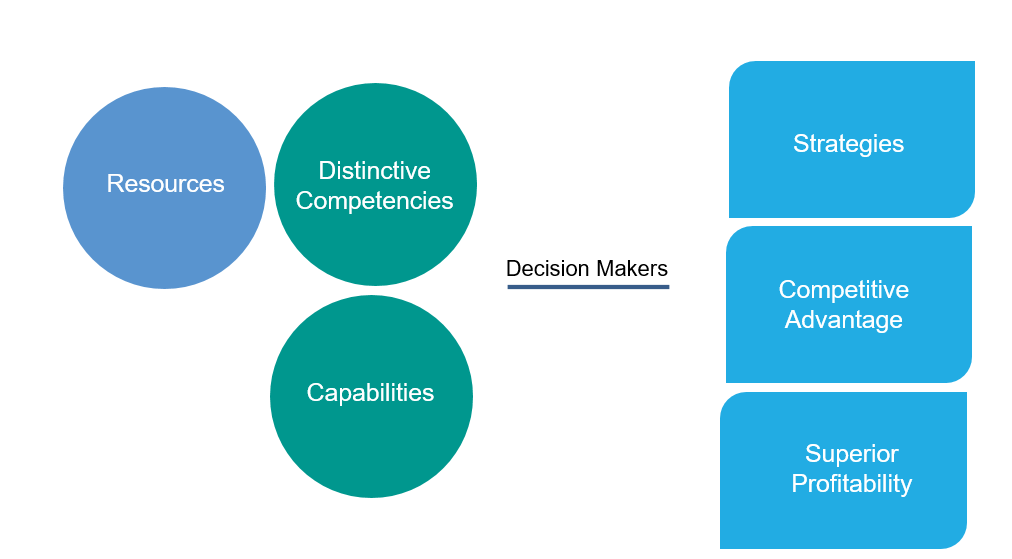
Simply put, this view suggests that organisations have many resources and capabilities, but only a limited number make a difference. Which ones make a difference is not always obvious. As well, resources and capabilities are intimately connected, so that resources support capabilities, and capabilities shape how resources are ‘exploited’ or used.
The VRIO tool (Johnson et al, 2014)[4] can be useful to highlight an organisation’s unique capabilities. The four criteria are applied in a cumulative sequence:
- Value: if the firm discards the resource or capability do customers still buy the product or service?
- Rareness: how many competitors have the same?
- Imitability: how costly is it to imitate?
- Organisation: is the firm structured to capture the value?
A resource/capability that satisfies all four of the above criteria is thought to be a foundation for competitive advantage, or long term organisational success in a public sector context (Johnson et al, 2014:76).
We will help you explore the VRIO framework in the Workshop as it can be very useful to highlight an organisation’s unique capabilities. VRIO framework template
Required
Peloso, T. (2019b). Introducing VIRO – Dr Tony Peloso
. GSBVid.
Completing the SWOT analysis
As a wrap-up to the internal half of the SWOT, the focus is to leverage strengths of the organisation, and mitigate and address weaknesses. Given our strengths-based approach to leadership that you explored in GSZ632 Managing Self and Others, what can we leverage from our Strengths?
What can you learn from the organisation’s Weaknesses? Is there a pattern? Are they about People, Systems, or Resources? Is there a message here? Can you address the Weaknesses or are these indicators of serious deficits, or a support to make decisions regarding which of the organisation’s Strengths and Opportunities to leverage?
There is an important link between an organisation’s resources and capabilities, and its environment. Be sure to consider this link when exploring the efficacy and likely successes of your strategies, operations and implementations.
Once the strategy team has completed a SWOT and VRIO analysis (which we will explore in your Workshop), the idea is to look for insights and also then explore innovative ways to combine these analyses to find additional dynamics and observations. Remember that applying the tools is the first step – what do the outcomes of those analyses mean, what do we now know and most importantly, “What can we now DO” – is the power of the process!
Required
30 mins
Preparation for the Workshop
Complete your draft SWOT by exploring the SW section.
In preparation for the Workshop, now refer back to your partly completed SWOT analysis.
Please begin to look around your organisation and department, and begin to populate the SW sections of the SWOT analysis of your context, to be included in your Workplace Project. When examining the Internal factors in your SWOT analysis, look for previous successes and also projects and initiatives that have had less than ideal outcomes. What are the internal dynamics, processes, capabilities etc. that are present, or absent?
Please bring these to the Workshop.
Note: As you continue to complete your SWOT analysis, remember that we will guide you through the Strategic Opportunities component of the Template during the Workshop.
- Van der Heijden, K., Bradfield, R., George Burt, G., George Cairns, G. & Wright, G. (2002). The Sixth Sense: Accelerating Organizational Learning with Scenarios. Wiley and Sons. ↵
- Jackson, M. C. (2003) Systems Thinking: Creative Holism for Managers. Chichester, UK: John meyWiley and Sons. ↵
- Johnson, G., Whittington, R. & Scholes, K., Angwin, D. & Regner, P. (2014). Exploring Strategy: Text and Cases (10th ed.). UK: Pearson. ISBN: 9781292007007. ↵
- Johnson, G., Whittington, R. & Scholes, K., Angwin, D. & Regner, P. (2014). Exploring Strategy: Text and Cases (10th ed.). UK: Pearson. ISBN: 9781292007007. ↵

